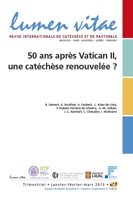 previous article in this issue previous article in this issue | next article in this issue  |

|
Document Details : Title: La présence de l'Église sur Internet Subtitle: Des enjeux aussi théologiques Author(s): JOIN-LAMBERT, Arnaud Journal: Lumen Vitae Volume: 66 Issue: 3 Date: 2011 Pages: 277-294 DOI: 10.2143/LV.66.3.2985300 Abstract : Depuis 15 ans, l’Église catholique s’y est progressivement investie, par ses institutions et aussi par ses membres individuellement ou en petits groupes et communautés. Cet article constate d’abord cette dynamique, y compris dans les exhortations du Magistère romain, avec une tendance à l’utilisation du média surtout comme canal d’annonce. La bonne volonté qui anime cette démarche kérygmatique ne peut cependant pas suffire. En faisant appel à la notion de style théologique de Chr. Theobald, l’auteur propose des critères proprement théologiques pour évaluer comment l’Église se dit en s’affichant sur Internet. En limitant l’étude à des sites web institutionnels, avec l’exemple des synodes diocésains – institutions particulièrement révélatrices de l’ecclésiologie du Concile Vatican II – l’auteur retient trois grandes notions théologiques traduisant la manière dont l’Église se comprend et se manifeste (style), permettant de proposer trois critères: la participation active, l’Église comme communion, le sacerdoce commun. Ces trois notions s’appliquent autant à ce que l’Église veut montrer au monde d’elle-même qu’à ce qu’elle dit à ses propres membres sur ce qu’elle propose comme manière de vivre ensemble la foi. For the past 15 years, the Internet has grown spectacularly and at an exponential rate. The Catholic Church has gradually invested in the medium, through its institution as well as by individual members, small groups and communities. This article begins by taking note of this dynamic, including as it is expressed in the exhortations of the Roman Magisterium, with a tendency to use the medium primarily as a channel for proclamation. The good will that lies behind this kerygmatic approach is not, in itself, sufficient. Drawing on C. Theobald’s notion of theological style, the author suggests specifically theological criteria for use in evaluating that are specifically theological to be used in evaluating how the Church presents itself through its Internet presence. By limiting the study to institutional websites, taking diocesan synods as an example – institutions that particularly reflect the ecclesiology of the Second Vatican Council – the author retains three great theological notions that reflect the Church sees and manifests itself (style). These can be expressed in three criteria: active participation, the Church as Communion, and the priesthood of all believers. These three notions apply both to what the Church wishes to show the world about itself and to what it says to its own members as regards what it proposes as a way of living the faith together. |
